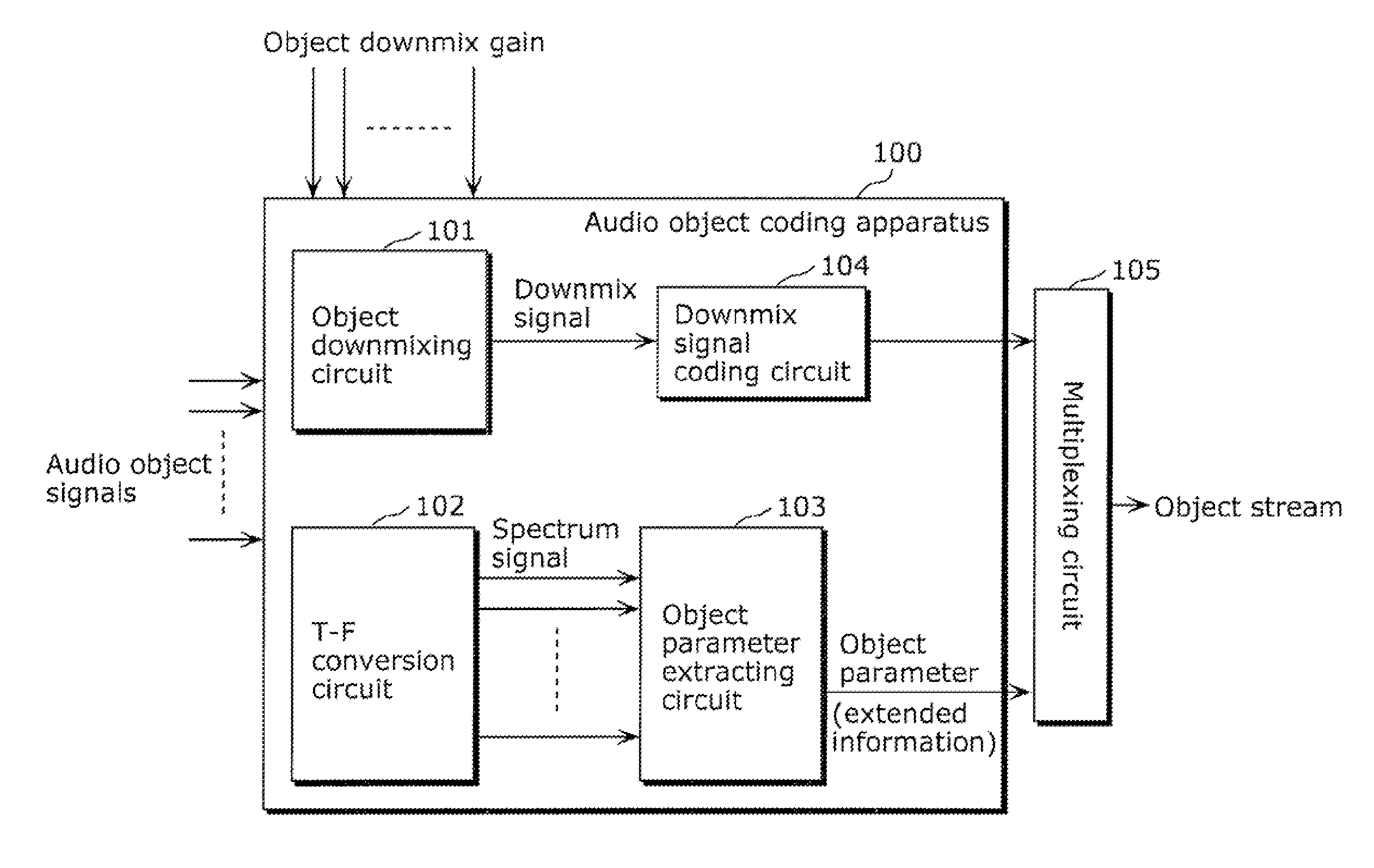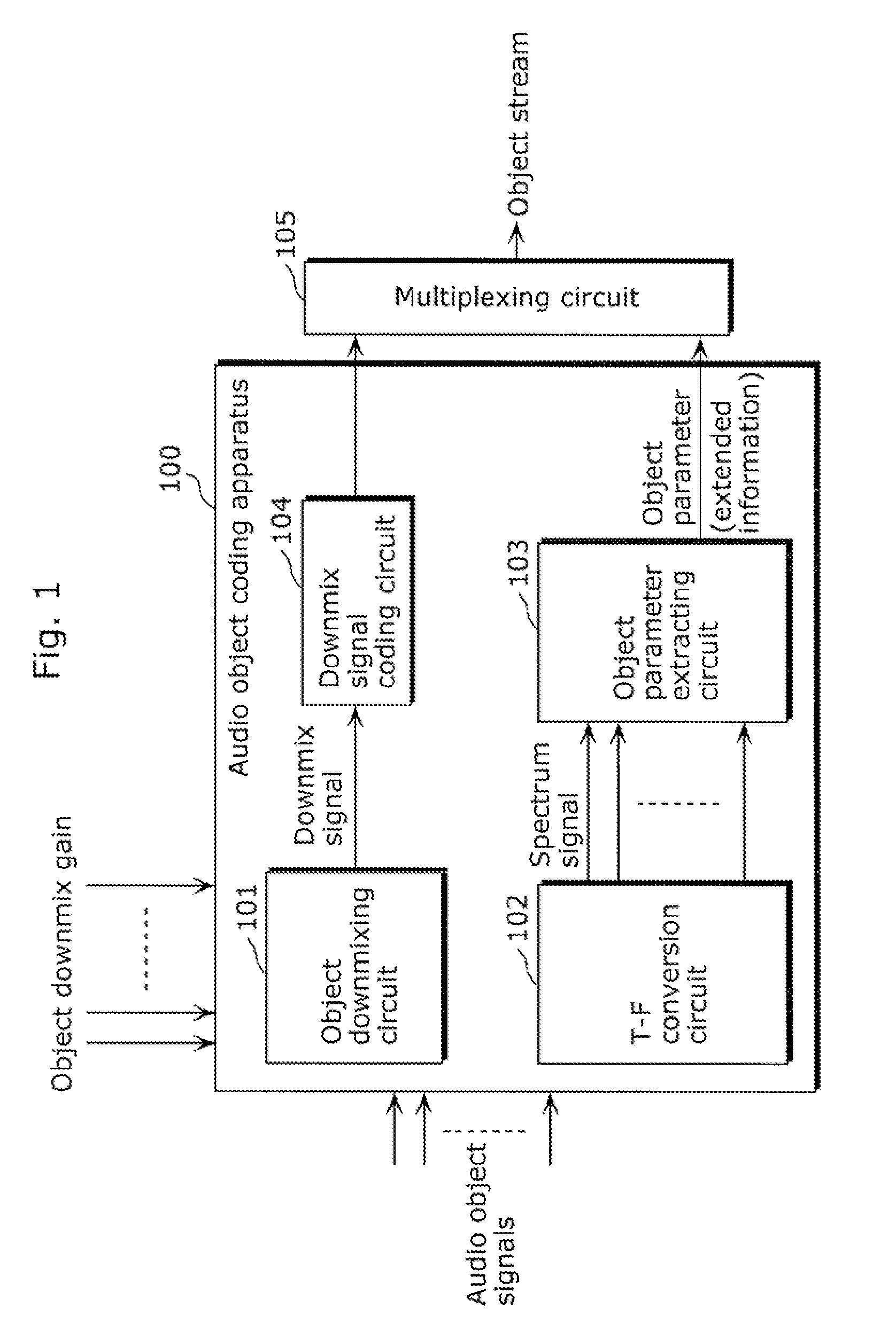Coding apparatus and decoding apparatus
a decoding apparatus and coding technology, applied in the field of decoding apparatuses, can solve the problem of not being able to provide all essential applications with coded audio with sufficient quality, and achieve the effects of improving the bit efficiency of coded information, reducing the extreme increase in bit rate, and improving the audio quality of decoding signals
- Summary
- Abstract
- Description
- Claims
- Application Information
AI Technical Summary
Benefits of technology
Problems solved by technology
Method used
Image
Examples
embodiment 1
[0083]First, descriptions for a coding apparatus will be given.
[0084]FIG. 4 is a block diagram which shows an example of a configuration of an audio object coding apparatus according to the present invention.
[0085]An audio object coding apparatus 300 shown in FIG. 4 includes: a downmixing and coding unit 301; a T-F conversion circuit 303; and an object parameter extracting unit 304. In addition, the audio object coding apparatus 300 includes a multiplexing circuit 309 in a subsequent stage.
[0086]The downmixing and coding unit 301 includes an object downmixing circuit 302 and a downmix signal coding circuit 310, downmixes provided audio object signals to reduce the number of channels, and codes the downmixed audio object signals.
[0087]More specifically, the object downmixing circuit 302 is provided with audio object signals and downmixes the provided audio object signals so as to be downmix signals which have the lower number of channels than the number of channels of the provided au...
embodiment 2
[0144]In the present embodiment, classifying audio object signals into classes is the same as Embodiment 1. Other parts; that is, the differences are described in the present embodiment.
[0145]In the present embodiment, object parameters (extended information) included in an audio object signal is extracted from the audio object signal in the frequency domain based on a reference class pattern. Then, all of the provided audio object signals are classified into several classes. Here, all of the audio object signals are classified into four types of classes including the reference class, by allowing two types of the temporal segments. Here, Table 1 indicates criteria for classifying an audio object signal i.
[0146]
TABLE 1Criteria ofClassificationDetails of ClassificationClassificationAThe case where each of the audioNtri = Vtrref and ifobject signals includes a temporalNtrref = , Tri(Ptrref) =segment and a position of temporalsegment of the pattern same as apattern of the reference clas...
embodiment 3
[0187]Next, in Embodiment 3, another aspect of the decoding apparatus which decodes a bitstream generated by the parametric object coding method which uses the technique of classification is described.
[0188]First, a general multi-channel decoder (spatial decoder) is explained for the purpose of comparison. FIG. 11 is a diagram which shows a general audio object decoding apparatus.
[0189]The audio object decoding apparatus shown in FIG. 11 includes a parametric multi-channel decoding circuit 700. Here, the parametric multi-channel decoding circuit 700 is a module in which a core module in the multi-channel signal synthesizing circuit 208 shown in FIG. 2 is generalized.
[0190]The parametric multi-channel decoding circuit 700 includes: a preprocess matrix arithmetic circuit 702; a post matrix arithmetic circuit 703; a preprocess matrix generating circuit 704; a postprocess matrix generating circuit 705; a linear interpolation circuits 706 and 707; and a reverberation component generating...
PUM
 Login to View More
Login to View More Abstract
Description
Claims
Application Information
 Login to View More
Login to View More - R&D
- Intellectual Property
- Life Sciences
- Materials
- Tech Scout
- Unparalleled Data Quality
- Higher Quality Content
- 60% Fewer Hallucinations
Browse by: Latest US Patents, China's latest patents, Technical Efficacy Thesaurus, Application Domain, Technology Topic, Popular Technical Reports.
© 2025 PatSnap. All rights reserved.Legal|Privacy policy|Modern Slavery Act Transparency Statement|Sitemap|About US| Contact US: help@patsnap.com



